I haven't been updating my Plan Ahead sub-blog because I haven't been planning ahead. I've been doing whatever strikes me at the moment as a good idea, which mostly means staying in bed as long as possible and then getting back into bed as early as possible. So when I heard, nearly at the last possible moment, that Lisa Hunter was having a book launch party at Winkleman/Plus Ultra, I decided to go and I didn't warn anyone I was going. And almost just before I left Stephanie Lee Jackson wrote to me to ask if I was going to be there. Having her show up was good news for me: I find it's impossible at these things to really talk to the host or the guest of honor for long, so if you don't have anyone else to talk to (and I usually don't) you stand around awkwardly for a bit and then go home. No fun.
I met Lisa for the first time, then, which was nice. I don't read her blog as regularly as I might -- I'm not an art collector because I don't have enough money for art supplies half the time, let alone other people's art -- but I do drop in from time to time and I like her writing. I didn't even get to buy a copy of her book for her to sign because on this particular day I was so short on funds if I didn't have EZPass I wouldn't even have been able to pay the Lincoln Tunnel toll.
Meeting Lisa was good and I also met John Morris of Digging Pitt, another blog I'm sorry to say I don't read much. Not that I don't like him, just that Pittsburgh is a million miles away and I have enough to keep up with around here. I'm probably going to read both of them more often now, though, since I tend to care more about people I've met in person. John was very talkative and interesting and quite intelligent, which is a nice change of pace from most art world people I meet. If Ed's gallery was more encouraging of good conversation it would've been a great time; Ed really needs to get something on the ceiling to improve the acoustics. I hereby volunteer to help with installation, and if I ever have money again I'll gladly pitch in funds, too. Maybe he could just glue up all my failed paintings (face to the ceiling, of course).
Lisa and Sara Jo also opened up Schroeder Romero next door as a show of solidarity with their neighbor, so I got to see the show they had up. Stephanie and I were looking at the work and chatting when Lisa tossed in from across the room, "He'll probably write something bad about it on his blog."
I feel bad about that. The fact is, I almost feel like the little connected spaces of Winkleman and Schroeder Romero are a home away from home for me. Ed and Lisa and Sara Jo never fail to make me feel welcome. They're always nice and willing to talk and listen and I love all three of them dearly. Every time I see Lisa I want nothing more than to hug her.
But. You could hear the but coming, couldn't you? But we just don't have the same taste in art. I think we're all fine with that -- gallerists understand, more than a lot of people, I think, that it takes all kinds. They don't require that you agree with them to be their friend. Which is wonderful. At the same time, I really wish I did agree with them. I just don't. I've had to accept that they are going to regularly put up shows that I not only don't like but sometimes think should be put out with the garbage.
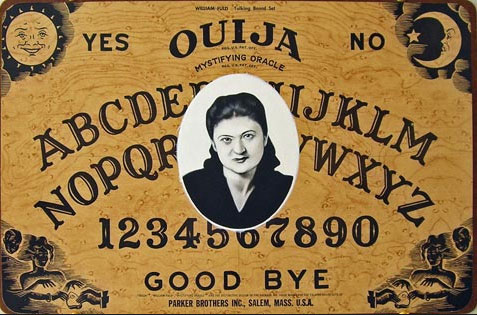 At least that wasn't the case this time. I saw Proof of Mary by Lordan Bunch. The paintings are immediately striking; they're realistic portraits and that tends to stand out. Something is slightly off about the images, though. Part of it is technique: Lordan just doesn't seem quite up to the style he's using. There's an uncertainty to it, a slight amateur feeling. Part of it is the images themselves, which are somewhat confounding in their mix of color and black and white, the range of archaic hairstyles of the sitters, the variation from Hollywood glamor to immigrant hausfrau. A number of the portraits are done on Parker Brothers Ouija boards.
At least that wasn't the case this time. I saw Proof of Mary by Lordan Bunch. The paintings are immediately striking; they're realistic portraits and that tends to stand out. Something is slightly off about the images, though. Part of it is technique: Lordan just doesn't seem quite up to the style he's using. There's an uncertainty to it, a slight amateur feeling. Part of it is the images themselves, which are somewhat confounding in their mix of color and black and white, the range of archaic hairstyles of the sitters, the variation from Hollywood glamor to immigrant hausfrau. A number of the portraits are done on Parker Brothers Ouija boards.
I might have just been mildly confused and curious if Stephanie hadn't been with me. I mentioned that I thought the paintings were pretty good.
"So he just took portraits from gravestones and painted them," she said.
Aha, that's it! (And if I ever read gallery verbiage, I would've known that, because they explain it there.) I admit to ignorance here: The cemeteries I've been in (not that I frequent cemeteries) never had those little gravestone portraits on them. In fact I'd never even seen them until a couple of years ago when my kids insisted I take them on a walk through a nearby cemetery; most of the markers there have photos on them. It's an Eastern Orthodox cemetery and I was brought up Roman Catholic. I don't think Italians are big on gravesite photos, and I found them a little creepy. Although, thinking about it, it's kind of nice to imagine what these people were like in life, rather than thinking they're big blocks of granite with angels on top.
In any case, I didn't realize all the paintings were taken from grave markers. I wish I had, because I'd even considered a project using photo grave markers. I had this idea -- which I shared with Stephanie there -- of painting little grave markers, but instead making each one a vulva portrait.
"We're going to have a little talk, you and I," Stephanie told me.
Well, it wasn't a serious project. Just a goofy idea. And those grave markers are expensive! I mean, I guess I could just paint some by hand and fire them like regular ceramic pieces....
Right. Little talk. Not a good project. Moving on.
Lordan's repurposing of the grave photos makes them mysterious -- in fact, adds a mystery they totally lack in their original context. The mystery is, what do these photos (or paintings) mean? Once you know what they are, the mystery evaporates. I found myself wondering what could take its place. There's a feeling of empathy for these women; and also a feeling that Lordan has robbed their graves, if not literally then symbolically. He's taken someone's desire to remember their loved one and twisted it for his own ends. In fact it feels a little shallow and contemptuous: "Here's what ignorant people use to try to contact their deceased loved ones, and here's the dopey photo they chose to remember them by."
But then my feelings shift. I think that maybe Lordan has treated these women with some respect. We wouldn't know or remember them -- wouldn't care at all -- if he hadn't lifted their images out and placed them in a new context. And the images, like the Ouija boards, are really just expressions of the human desire to maintain some connection to the people we've loved.
My feelings about the show ended up being the same as my feelings about the paintings in the show: I liked them but didn't like them. I guess you'd say I am ambivalent. Which I'd say means the show is a success: I'd rather a show make me think than a show simply please me and leave my mind immediately after I walk away.
I will say this: The fact that my friends and I have such different tastes in art has helped me to clarify what I do and do not like. Writing about it and talking about it has done wonders. It's turned art appreciation into an active project for me, and that's well worth the discomfort of having to tell someone I like that, no, this show just isn't for me.
I wish I could say more about The Intrepid Art Collector: The Beginner's Guide to Finding, Buying, and Appreciating Art on a Budget at this point because the party was for Lisa, after all. But I haven't read it and so I can't say much. I like the cover design. I do recommend you buy a copy because I want people I know to be successful and happy and all. I'm sure it's an excellent book. Buy a copy for a friend while you're at it.
 At least that wasn't the case this time. I saw Proof of Mary by Lordan Bunch. The paintings are immediately striking; they're realistic portraits and that tends to stand out. Something is slightly off about the images, though. Part of it is technique: Lordan just doesn't seem quite up to the style he's using. There's an uncertainty to it, a slight amateur feeling. Part of it is the images themselves, which are somewhat confounding in their mix of color and black and white, the range of archaic hairstyles of the sitters, the variation from Hollywood glamor to immigrant hausfrau. A number of the portraits are done on Parker Brothers Ouija boards.
At least that wasn't the case this time. I saw Proof of Mary by Lordan Bunch. The paintings are immediately striking; they're realistic portraits and that tends to stand out. Something is slightly off about the images, though. Part of it is technique: Lordan just doesn't seem quite up to the style he's using. There's an uncertainty to it, a slight amateur feeling. Part of it is the images themselves, which are somewhat confounding in their mix of color and black and white, the range of archaic hairstyles of the sitters, the variation from Hollywood glamor to immigrant hausfrau. A number of the portraits are done on Parker Brothers Ouija boards.
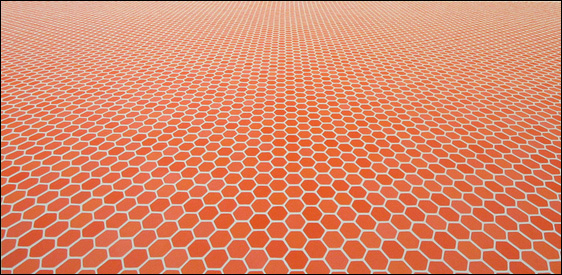 I
I 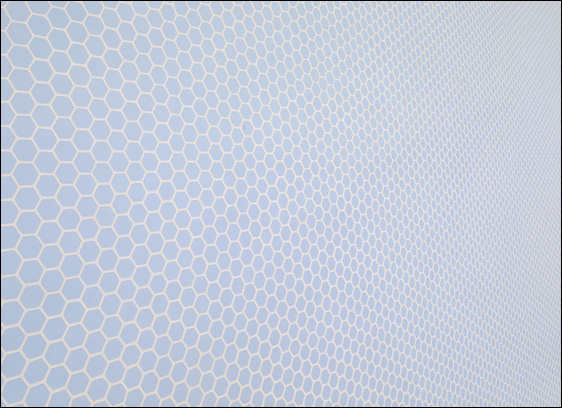 Sara was willing to meet me to take me through her paintings, so we got together for an hour or so on November 3. (Perhaps now would be a good time to read this side note on
Sara was willing to meet me to take me through her paintings, so we got together for an hour or so on November 3. (Perhaps now would be a good time to read this side note on 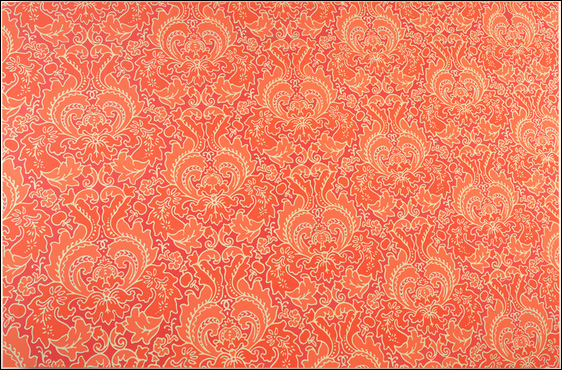 These paintings occupy a wonderful space in art, too. They're fantastically accessible but there's a lot of painterly subtlety in them. Sara told me she found herself at this point, painting these akimbo fields of tiles or wallpaper patterns, by going from figure painting through landscape painting and out to these simplified, abstracted, seemingly infinite surfaces. Each one seems recognizable because each painting is inspired by a real surface. They are, really, very particular landscapes.
These paintings occupy a wonderful space in art, too. They're fantastically accessible but there's a lot of painterly subtlety in them. Sara told me she found herself at this point, painting these akimbo fields of tiles or wallpaper patterns, by going from figure painting through landscape painting and out to these simplified, abstracted, seemingly infinite surfaces. Each one seems recognizable because each painting is inspired by a real surface. They are, really, very particular landscapes.
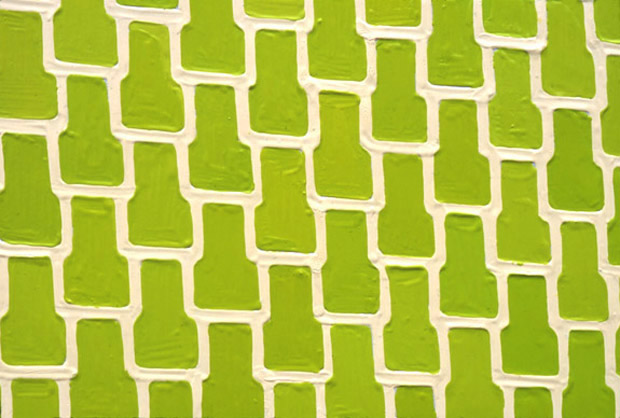 She uses a computer to help her play with the perspective before she lays it out, and then marks off a grid on her panel to guide her painting. But after that it's a manual process and it shows. Looking at her online reproductions you might think she could simply print these out from an inkjet, but when you see them in person it's clear how handmade these really are. The whole surface is wonderfully alive with the imperfections of oil painting: Differences in paint thickness, slight alligatoring here and there, a drip and a spatter maybe; maybe a spot where two adjacent colors don't quite line up. It's interesting because I can see where a less talented painter might have chosen her subject but tried to paint it as flat as possible; or where another painter might have chosen her less-than-perfect style but used it on entirely different subjects. The brilliance of Sara's paintings lies in her combination of the two; they vibrate and change the air in front of them.
She uses a computer to help her play with the perspective before she lays it out, and then marks off a grid on her panel to guide her painting. But after that it's a manual process and it shows. Looking at her online reproductions you might think she could simply print these out from an inkjet, but when you see them in person it's clear how handmade these really are. The whole surface is wonderfully alive with the imperfections of oil painting: Differences in paint thickness, slight alligatoring here and there, a drip and a spatter maybe; maybe a spot where two adjacent colors don't quite line up. It's interesting because I can see where a less talented painter might have chosen her subject but tried to paint it as flat as possible; or where another painter might have chosen her less-than-perfect style but used it on entirely different subjects. The brilliance of Sara's paintings lies in her combination of the two; they vibrate and change the air in front of them.
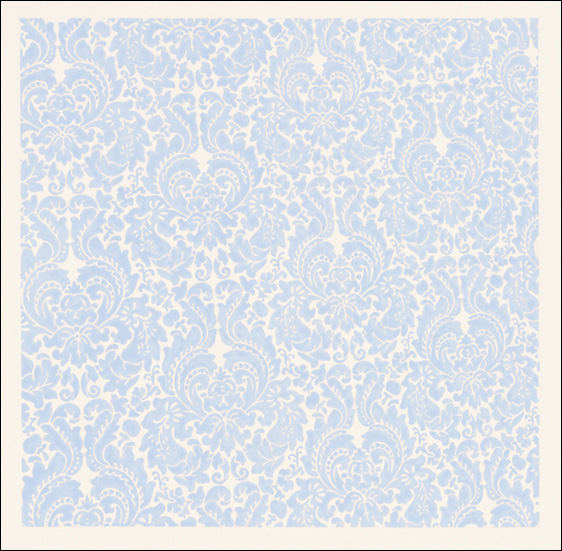 In addition to the paintings Sara also has some gouaches up. They look curiously flocked and remind me strongly of my Aunt Joan's wallpaper, only hers had gold veins and red velvet flocking. I'm not sure I like Sara's wallpaper designs as much as I like her tilings, but they're the flip side of each other: As she makes explicit when she titles a diptych inside outside, her tilings are the outer walls and her wallpaper the inner.
In addition to the paintings Sara also has some gouaches up. They look curiously flocked and remind me strongly of my Aunt Joan's wallpaper, only hers had gold veins and red velvet flocking. I'm not sure I like Sara's wallpaper designs as much as I like her tilings, but they're the flip side of each other: As she makes explicit when she titles a diptych inside outside, her tilings are the outer walls and her wallpaper the inner.
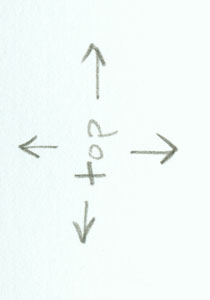 One thing I had to ask Sara was whether her paintings had a definite orientation. I was thinking about this because just a couple of days earlier I'd gotten a couple of drawings in the mail from
One thing I had to ask Sara was whether her paintings had a definite orientation. I was thinking about this because just a couple of days earlier I'd gotten a couple of drawings in the mail from 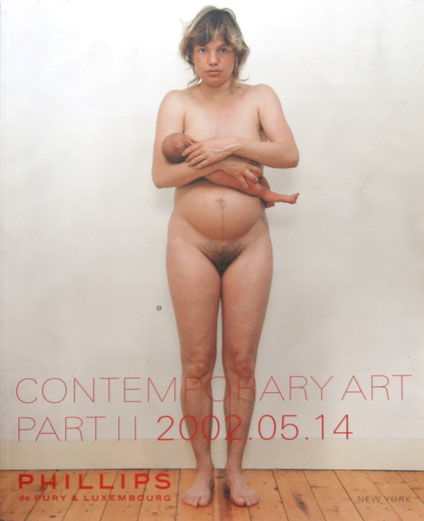 It so happened the last time I was in Chelsea that I wandered by Gallery Henoch -- rapidly becoming one of my favorite places -- and found they were clearing out several years' accumulation of auction catalogs. I grabbed a couple, just because they were free and seemed neat. Also, one had a photo of a nude woman nursing a baby on the front, and I just love moms when they're naked.
It so happened the last time I was in Chelsea that I wandered by Gallery Henoch -- rapidly becoming one of my favorite places -- and found they were clearing out several years' accumulation of auction catalogs. I grabbed a couple, just because they were free and seemed neat. Also, one had a photo of a nude woman nursing a baby on the front, and I just love moms when they're naked.
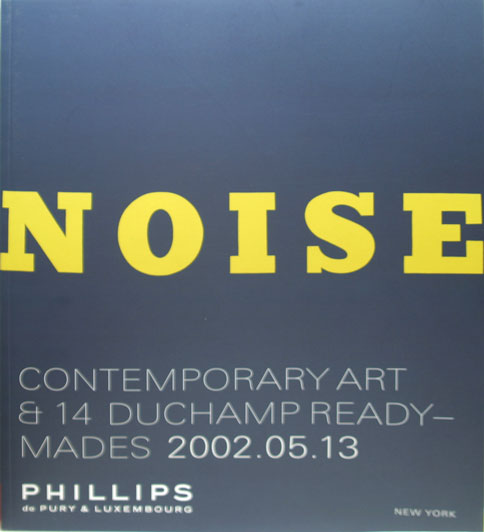 The next thing I noticed was that one of the catalogs, to my surprise, was for an auction including 14 of Marcel Duchamp's readymades. It seems that Phillips de Pury & Luxembourg sold Arturo Schwarz's collection of Duchamp back in 2002. Well, most of it. Not every piece sold.
The next thing I noticed was that one of the catalogs, to my surprise, was for an auction including 14 of Marcel Duchamp's readymades. It seems that Phillips de Pury & Luxembourg sold Arturo Schwarz's collection of Duchamp back in 2002. Well, most of it. Not every piece sold.

